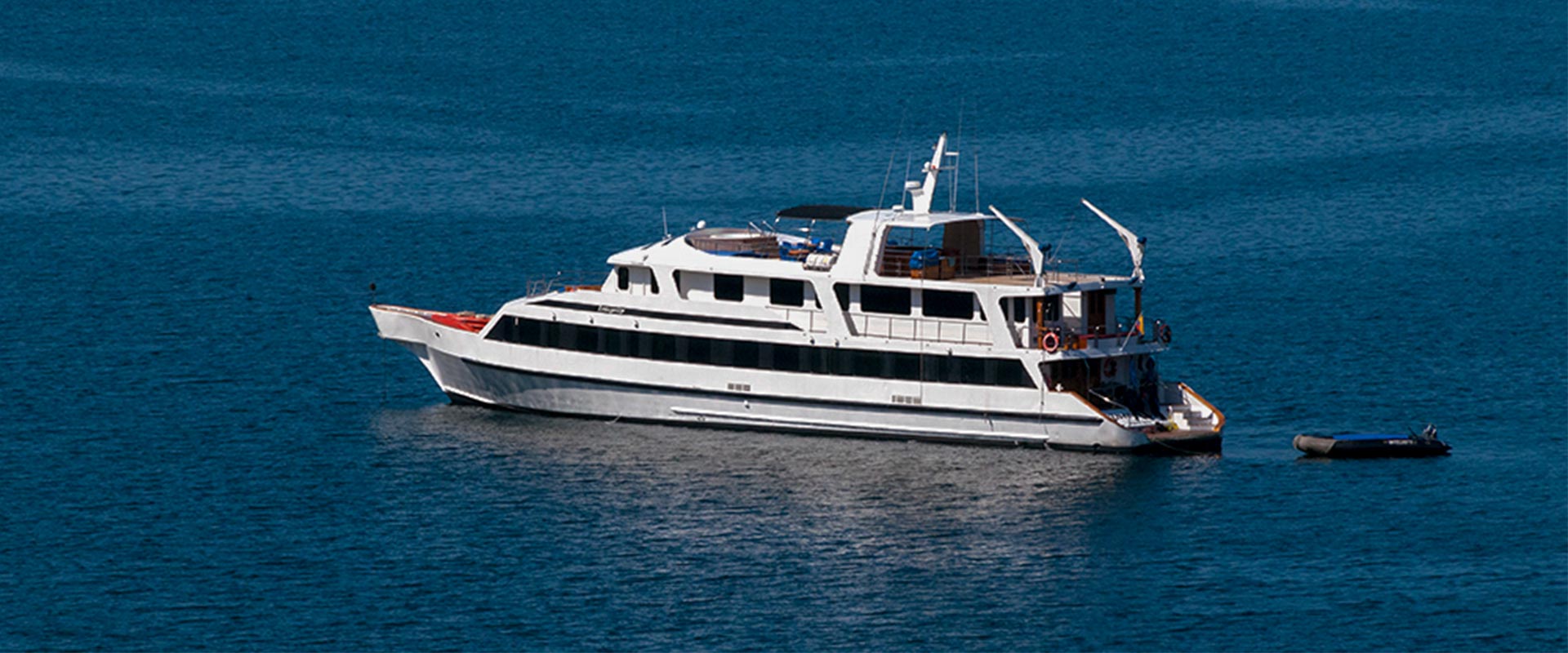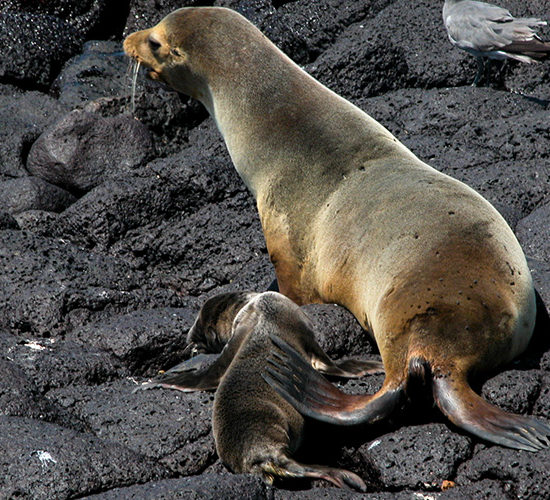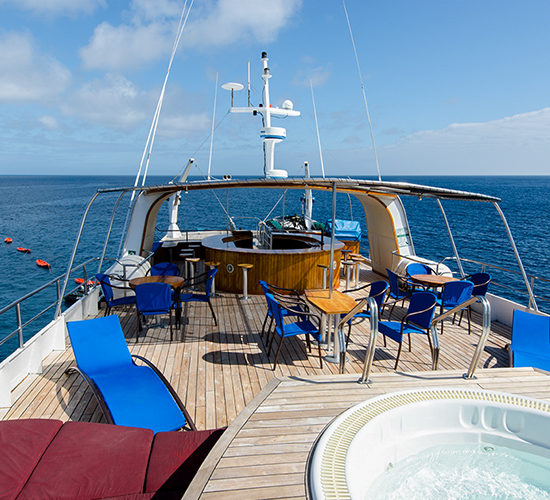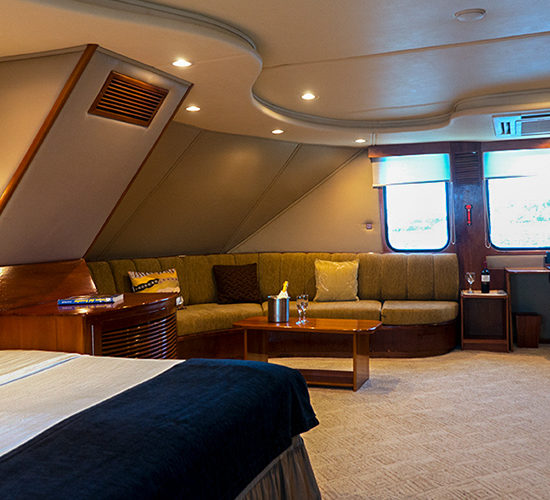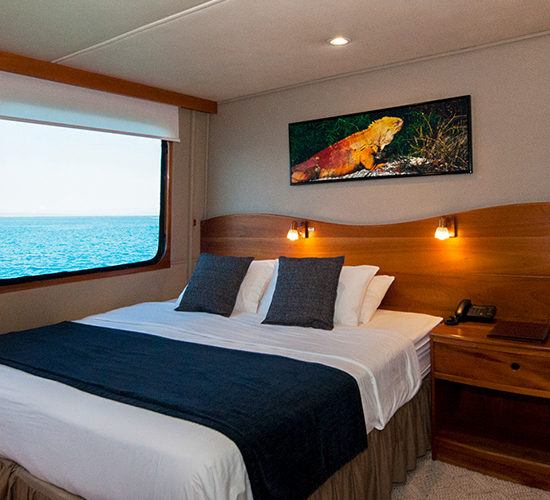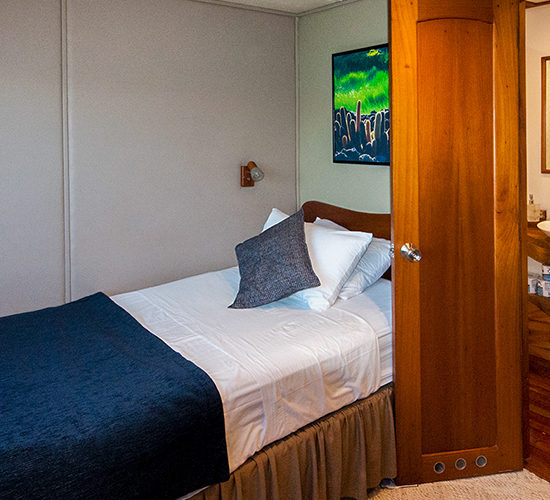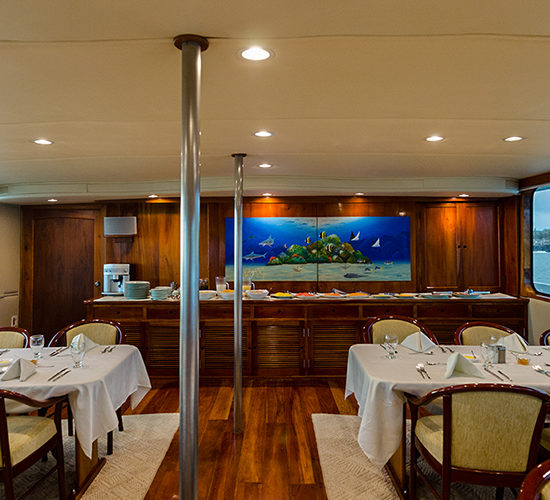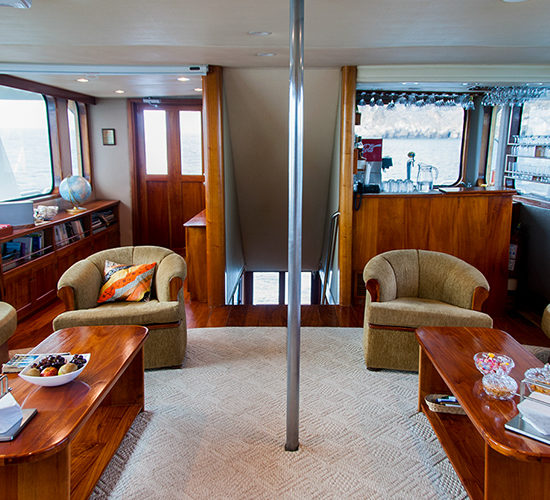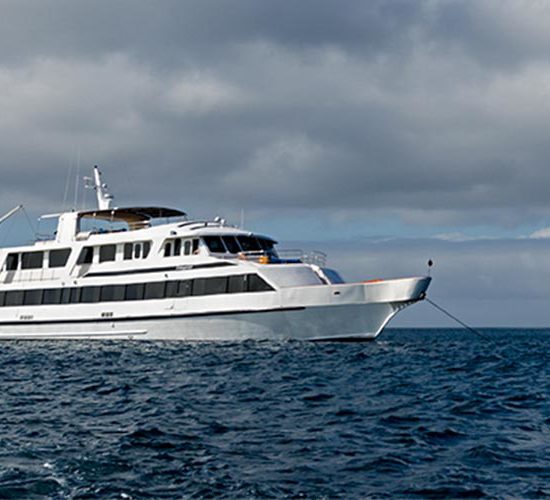Motor Yacht Integrity
Special Features:
Capacity: 16 guests
Departure day: Saturday
Cruise length: 8 days
Available: Kayaks, snorkelling equipment, wetsuits, jacuzzi, two glasses of wine per night.
Ideal for honeymoon or anniversary trips
Ideal for Family or small group charters
Special interests charters with exclusive VIP amenities
Islands to visit, depending on the itinerary:
Eastern route: Santa Cruz Island, Española Island, San Cristobal Island, Santa Fe Island, Plazas Island, Genovesa Island, Santiago Island, Bartolome Island, Rabida Island, Chinese Hat Island.
Western route: Santa Cuz Island, Floreana Island, Isabela Island, Fernandina Island, Santiago Island, North Seymour Island.
Integrity yacht is one offers you to cruise the Galapagos Islands with comfort and high standard service
This wonderful yacht has spacious cabins and social areas to offer great comfort to guests whilst admiring the Galapagos Islands. The Integrity yacht features 9 comfortable staterooms with single and double accommodation. Crew members and guide are very friendly and always willing to assist you with all requirements.
INTEGRITY YACHT - BRIEF EASTERN ITINERARY
Please check complete itineraries on top
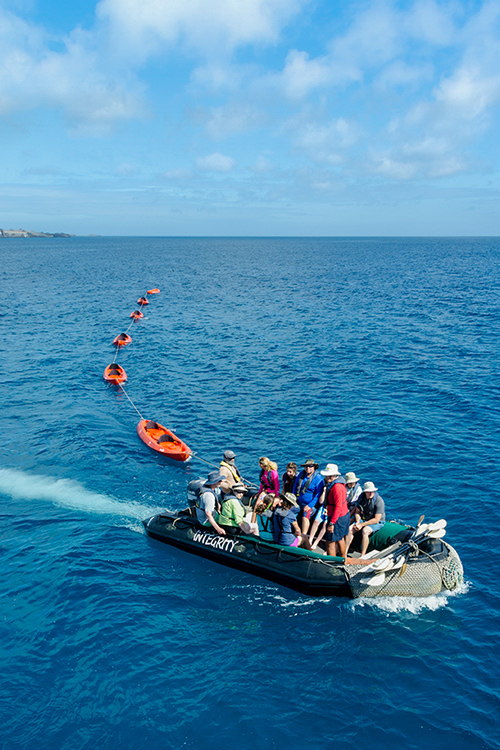
Saturday: Baltra airport & Santa Cruz Island
- AM: Arrival at Baltra airport and transfer to the cruise
- PM: Santa Cruz Island – Highlands and Charles Darwin Station
Sunday: Española Island
- AM: Gardner Bay
- PM: Suarez Point
Monday: San Cristobal Island
- AM: Pitt Point
- PM: Wizard Hill & Kicker Rock
Tuesday: Santa Fe & South Plaza Islands
- AM: Santa Fe Island
- PM: South Plaza Island
Wednesday: Genovesa Island
- AM: Darwin beach
- PM: Prince Phillip’s Steps
Thursday: Santiago & Bartolome Islands
- AM: Sullivan Bay
- PM: Bartolome Island
Friday: Rabida & Chinese Hat Islands
- AM: Rabida Island
- PM: Chinese Hat Island
Saturday: Baltra Island, to take your flight back to Quito or Guayaquil
INTEGRITY YACHT - RATES
Rates are per person
| Cabin type | Regular season | Fall | Winter Holiday |
| Staterooms | $8.795 | $7.995 | $9.995 |
| Owner’s Suite | $11.195 | $10.395 | $12.395 |
| Children under 12 years : $500 off | |||
| Single Supplements | |||
| Stateroom #2 | $1.800 | $1.800 | $1.800 |
| Staterooms | $8.355 | $7.595 | $9.495 |
| Owner’s Suite | $11.195 | $10.395 | $12.395 |
| Charter rates | |||
| 16 guests | $129.500 | $116.700 | $162.320 |
Regular Season: 05 Jan-31 Aug / 23 Nov
Fall Season: 28 Sep – 16 Nov / 30 Nov-14 Dec
Winter Holiday: 21 Dec / 28 Dec
Included:
Accommodation
All Meals (from lunch on the first day to breakfast on last day)
Drinking water, coffee and tea
Guided visits with a naturalist guide
Use of snorkelling equipment
Use of wetsuits
Use of kayaks
Two glasses of wine at dinner, per night
Transfers to and from the airport in Galapagos
Additional:
Galapagos flight ticket
Galapagos entrance fee ($100 per adult & $50 per child, subject to change)
Galapagos migration card ($20 per person)
Soft and alcoholic drinks
Additional tours and transfers
Personal expenses
Meals that are not mentioned
Travel insurance (strongly suggested)
Tips & gratuities
All that is not mentioned
We'd love to help you plan your trip!
Please let us know about your plans
Ready to step into this expedition?
Please fill out the form let us guide you through your next dream holiday!
-
Departure/Return Location
Quito or Guayaquil | Baltra Island, Galapagos Islands -
Dress Code
Comfortable: Good walking shoes, cotton amd light pants, shorts, t-shirts, windbraker for the nights, cotton pullover, bathing suit, sandals, sunscreen, sunglasses, hat with a birm, binoculars, camera with a lot of memory, personal kit, personal medicine, water bottle, small back pack
Detailed Itinerary
8 DAY CRUISE: Eastern Route
Saturday: Baltra airport & Santa Cruz Island
AM: Santa Cruz Highlands — Visit the highlands of Santa Cruz Island for a special opportunity to view the islands’ most famous reptile: the giant tortoises in their wild habitat. What a privilege to see an endangered species roving in this lush environment! The vegetation of the area includes the Scalesia Forest (an endemic giant daisy tree) and birds such as the vermilion flycatcher will delight everyone with its scarlet feathers against an emerald green forest. Look for Darwin’s finches (most of them from the tree-finch group), particularly the famous Woodpecker Finch. PM: Charles Darwin Research Station and boarding yacht — Visit the Charles Darwin Research Station and Galápagos National Park headquarters and learn first hand of the conservation and research efforts in the islands. There, you see several subspecies of adult tortoises, lots of hatchlings, and learn of the repatriation programs that are saving several subspecies of tortoises and iguanas from extinction. Later In the afternoon, board your yacht, Integrity, for dinner and set sail on our Island cruise. You are going to live aboard the yacht and spend as much time exploring the islands as park rules permit. Each night, you travel on to the next destination.Sunday: Española Island
AM: Gardner Bay — Stroll along a magnificent white sand beach where sea lions lounge, marine turtles nest, and the curious Española mockingbirds follow our every footstep. You can take a brief swim on the beach or wait for an amazing snorkel in the company of schools of colourful fish, turtles, sea lions, and possibly small sharks along the underwater cliffs of Gardener-by-Española, a small satellite islet. PM: Punta Suárez — This is one of the Galapagos’ most famed visitor sites. You are dazzled by spectacular cliff views of pounding surf and seemingly unlimited populations of an amazing variety of seabirds. Brightly coloured marine iguanas and the largest lava lizards of Galapagos frequent the coastline and rest on the trail. From the cliff top, you watch a blowhole spray water 30 meters in the air. Española is the only island where you see waved albatrosses and possibly observe their fascinating mating dance.Monday: San Cristobal Island
AM: Punta Pitt — Disembarking onto the small beach, visitors are confronted by the unmistakable stench and cacophony of barking sea lions. This is a bachelor colony, and most are exhausted from fighting and mating. A steep gully leads up the cliff to a breeding ground for Boobies of all three varieties: Red-footed, Blue-footed and Nazca. It’s the only place in the Galapagos where you can see all three species nesting together. Two species of frigatebirds are also present, as are Swallow-tailed Gulls and Storm Petrels. The view of sea lions from the top of the cliff over the beach is magnificent, as are the contours of the barren, wind-eroded peaks of the island. The trail across the Punta Pitt site offers a closer look at the hardy vegetation that manages to thrive in this volcanic wasteland. From Saltbush and spiny shrubs next to the beach the trail leads up to an area of Palo Santo trees, big yellow-green shrubs, tiny cacti and, in the dry season, carpets of red Vesuvius. PM: Cerro Brujo & Kicker Rock — A short panga ride along the cliffs of Cerro Brujo will be followed by a visit to the lovely coral sand beach, frequented by waders and migrant birds. Snorkelers will see an amazing array of sea life at Kicker Rock, often including manta rays, sea turtles, and sharks. Non-snorkelers will enjoy a close cruise around dramatic Non-snorkelers will enjoy a cruise around the base of dramatic Kicker Rock, a 500 m vertical tuff cone. The orange glow on the rock at sunset is one of the more dramatic sights in all of Galapagos.Tuesday: Santa Fe and South Plaza Islands
AM: Santa Fe Island — After landing on a white beach usually covered with sea lions, you’ll walk into a giant Opuntia cactus grove where you’ll have the opportunity to see the endemic land iguanas. The land visit will be followed by snorkelling and/or kayaking in the turquoise waters of the bay, full of sea lions, rays, urchins, eels, and fish of all colours. PM: South Plaza Island — You see another species of Galapagos land iguana as well as cactus finches. Both North and South Plazas were formed by geological uplift and tilt to the north, with cliffs on their southern coasts. On small islands like this, terrestrial and marine species interact more than on the larger islands, and the occasional hybrid iguana (land and marine) with its “zebra-like” stripes can often be observed. The south-facing cliffs swarm with a myriad of bird species. Bachelor sea lions climb steep cliffs in the late afternoon to spend nights away from the larger dominant bulls.Wednesday: Genovesa Island
AM: Darwin Beach — At the north side of Darwin Bay, this beach was formed by the rim of a sunken crater. Red mangroves along the hiking trail provide habitat for yellow warblers, yellow-crowned night herons, and pintail ducks. The highlight of this site is the incredible abundance of Red-footed Boobies, Great Frigatebirds, Swallow-tailed Gulls, and Yellow-crowned Night Herons. Although the most abundant booby in the islands, this is one of the few places visitors can observe Red-footed Boobies. PM: Prince Phillip’s Steps — While riding in a panga along the base of the eastern cliffs of Darwin Bay, you’ll scour the cliff crevices for all kinds of animal life. You’ll come to a rockfall that forms a natural staircase up to the cliffs, known as Prince Phillip’s Steps or the “Stairway to Seabird Heaven.” Walk through massive colonies of Red-footed and Nazca Boobies and an extraordinary Palo Santo forest on the way to a lava ridge where thousands of storm petrels dart about while short-eared owls stalk them for prey.Thursday: Santiago and Bartolome Islands
AM: Sullivan Bay (Santiago) — Walk across a recent lava flow and view its beautiful structural characteristics. Formed in the second half of the 19th Century, the flow is too young for many plants or animal life. It is the lava itself and the contrasting black pahoehoe flow and the reddish-yellow tuff cones that are the stars of this visit. The colours and shapes of the lava are fantastic for photos. PM: Bartolome — Arguably the most recognized landmark in Galapagos, Pinnacle Rock juts straight out of Bartolomé’s northern bay. Snorkelling in the bay provides visitors with a chance to swim with Galapagos Penguins. Climbing up the 600-m trail to the top of the island provides spectacular views of Pinnacle Rock, Santiago Island, and Daphne Major and Minor.Friday: Rabida and Sombrero Chino Islands
AM: Rabida — Land at Red Beach where wading birds and ghost crabs dot the sand. Behind the beach is a saltwater lagoon where Pintail ducks and Common Stilts are frequently seen along with a group of bachelor sea lions. Brown pelicans nest in the nearby salt brush. A short trail inland provides a chance to observe finches, Galapagos Doves, Yellow Warblers, and mockingbirds, as well as the occasional snake. PM: Sombrero Chino — The turquoise waters near Sombrero Chino provide one of your best opportunities to see Galapagos Penguins. A panga ride in search of wildlife is followed by a snorkel that often includes sharks, sea lions, penguins, and rays. You will land at a beautiful white sand beach for a short walk along a trail that meanders over varying types of lava.Saturday: Baltra Island
AM — You have breakfast on board Integrity, then disembark at Baltra Island, for your flight back to Quito or GuayaquilB, L, D
Meals: B=Breakfast | L=Lunch | D=Diner NOTE: Itineraries are subject to change without previous notice due to weather conditions, National Park regulations or any other matter that might risk guests' safety.
8 DAY CRUISE: Western Route
Saturday: Baltra airport and Santa Cruz Island
AM: Santa Cruz Highlands — Visit the highlands of Santa Cruz Island for a special opportunity to view the islands’ most famous reptile: the giant tortoises in their wild habitat. What a privilege to see an endangered species roving in this lush environment! The vegetation of the area includes the Scalesia Forest (an endemic giant daisy tree) and birds such as the vermilion flycatcher will delight everyone with its scarlet feathers against an emerald green forest. Look for Darwin’s finches (most of them from the tree-finch group), particularly the famous Woodpecker Finch. PM: Charles Darwin Research Station and boarding yacht — Visit the Charles Darwin Research Station and Galápagos National Park headquarters to learn first hand of the conservation and research efforts in the islands. There, you’ll see several subspecies of adult tortoises, lots of hatchlings, and learn of the repatriation programs that are saving several subspecies of tortoises and iguanas from extinction. Later In the afternoon, you will board our yacht, Integrity, for dinner and set sail on your Island cruise. You will live aboard the yacht and spend as much time exploring the islands as park rules permit. Each night, you’ll travel on to the next destination.Sunday: Floreana Island
AM: Punta Cormorant & Champion Island — You’ll land on a green, olivine sand beach next to a large lagoon usually adorned with feeding flamingos and other water birds. A short hike through one of the more varied plant communities leads us to Flour Beach where sea turtles nest and small rays frolic in the surf. Enjoy snorkelling at Champion Island with curious, playful sea lions and hope to catch a glimpse of the rare Floreana Mockingbird. PM: Post Office Bay, Asilo de la Paz, Black Beach — First you’ll stop at the wooden barrel that has served as a mariner’s “post office” since the 18th Century where you have the opportunity to continue the “postmaster” tradition. Then head into the Floreana Highlands to visit a collection of tortoises and learn about the island’s intriguing human history at Wittmer Caves and one of Galapagos’ only freshwater springs. Your day ends with a walk on Black Beach and a barbecue onboard Integrity.Monday: Isabela Island
AM: Punta Moreno — Walk onto this young lava flow at the base of Cero Azul, past cacti and other early colonizing plants. This flow is dotted with numerous “oases” of brackish lagoons containing a wide variety of life, including flamingos, Paint-billed Crakes, White-cheeked Pintails, and Common Gallinules. PM: Elizabeth Bay — Silently float in skiffs through the narrow channels of this mangrove lagoon to see rays, Flightless Cormorants, penguins, pelicans, lava herons, sea turtles, sea lions, Blue-footed Boobies, many fish and other species that inhabit this vital zone.Tuesday: Isabela and Fernandina Islands
AM: Urbina Bay (Isabela) — This site is very unique. In 1954, volcanic activity caused a 6 km stretch of coastline to be uplifted 5 m in a matter of hours, stranding coral heads, and all sea life that couldn’t escape, more than a km away from the new shore. Walk among the skeletal coral garden, now home to lizards and mockingbirds. Urbina Bay is also home to large, colourful land iguanas. During certain times of the year you may encounter Alcedo tortoises which come down from the highlands to nest in the warm sands of Urbina Bay. PM: Punta Espinosa (Fernandina) — This peninsula is on the most pristine and youngest island of Galapagos. Fernandina is highly volcanically active with eruptions occurring frequently, the latest in 2008. Upon landing, you are met by an abundance of small, dark marine iguanas and brightly coloured Sally Lightfoot Crabs. Walk out on a pahoehoe lava flow—younger than the one at Punta Moreno—past a few pioneering plants. Along the sandy shore, you can see Flightless Cormorants, pelicans, and numerous, lounging sea lions. Sunsets are often stunning.Wednesday: Isabela Island
AM: Tagus Cove — Pirates and whalers in the 19th Century using Tagus Cove for anchorage left their marks on the cliffs of this sunken caldera, a tradition of graffiti that continues to today. A short, steep hike passes Darwin Lake, which sits within a tuff cone and is filled with salt water. This site is an excellent place for viewing land birds, including Ground and Tree Finches, Galapagos Hawks, Yellow Warblers, Large-billed Flycatchers and even sometimes the Woodpecker Finch. A rare sighting of land iguanas is a treat. A dinghy ride or kayak along the cliffs provides views of geologic features, as well as penguins and other bird species. PM: Punta Vicente Roca — The large cave and cleaved tuft cone and caldera wall are impressive geological formations and provide a beautiful backdrop for nesting birds, including Blue-footed and Nazca Boobies, gulls, storm petrels, and Brown Noddy Terns. It also forms a calm gathering area for sea turtles. Along with sea turtles, snorkelers can see many species of colourful fish, penguins, sea lions, sea anemones, small jellyfish, and other sea life.Thursday: Santiago Island
AM: Puerto Egas — There are two separate trails here. The first meanders along the coast to the fur seal grottoes, a safe haven for the shy Galapagos Fur Seal amongst the crags and swimming inlets, and home to American Oystercatchers, marine iguanas and ubiquitous sea lions. The second, less-used trail heads inland to a lagoon at the Salt Mine Volcano where flamingos and other birds are found. PM: Espumilla Beach and Buccaneer Cove — Espumilla is a red-sand beach and a sea turtle nesting site, with an inland trail that passes a small lagoon and into the arid zone where it is possible to view many land birds in a beautiful landscape, including Galapagos Hawks. While snorkelling at Buccaneer Cove, you may see sea lions, fur seals, sea turtles, rays, sharks, pelagic fishes, and amazing underwater geologic formations.Friday: Santa Cruz and North Seymour Islands
AM: Bachas Beach & Caleta Tortuga Negra — Enjoy a quiet and peaceful morning at Bachas’ fine, white beach. Two small lagoons just over the dunes sometimes host flamingos. “Bachas” comes from the remains of a barge which ran aground decades ago, leaving just a few rusty spines visible today. In Caleta Tortuga Negra enjoy a silent skiff ride to see sea turtles feed and mate in the calm waters, and three species of sharks, Spotted rays, egrets, and lava herons. Aboard we celebrate our last night together. PM: North Seymour — Snorkelers will enjoy their last underwater experience before we land on North Seymour, the flattest Island we’ll visit. The trail at North Seymour heads inland where we will see the largest colony of Magnificent Frigatebirds in Galapagos, Blue-footed Boobies, and occasionally land iguanas. Continue along the coast where you will have ample opportunity to observe sea lions and marine iguanas as we enjoy your final Island sunset.Saturday: Baltra Island
AM — Have breakfast on board Integrity, then disembark at Baltra Island to take your flight back to Quito or Guayaquil.B
Meals: B=Breakfast | L=Lunch | D=Diner NOTE: Itineraries are subject to change without previous notice due to weather conditions, National Park regulations or any other matter that might risk guests' safety.
Yacht Specifications
Length: 141 feet Beam: 24 feet Draft: 7 feet Tonnage: 318 tons Stabilizers: Vosper Active Fuel cap: 10,000 gal Range: 3,000 miles Desalinator: 2.500 gal/day Guests: 16 Crew: 10 Naturalist: 1Safety and Navigation
Life rafts: 2 - 25 person each Zodiacs: 2 - 16 person each Radar: 2 Sonar: 1 Depth Sounder: 1 DSC/VHF: 1 VHF: 1 DSC/HF radio: 1 Navtex: 1 Autopilot: 1 Closed circuit video surveillance in key areas EPIRB (Emergency Position-Indicating Radio Beacon) Smoke and fire detection and extinguisher systems Crew (ISM certified)Engine Specifications
Main engines: 2 Detroit - MTU Series 60, 4-cycle electronically controlled, set on Lo-Rez mounts and shaft couplings for vibration control Main generators: 2 Isuzu 96 kW 60 Hertz 120-240 Volts Emergency generator: Kubota 12 kW 60 Hertz 120-240 VoltsPassenger Amenities
Staterooms: 7 doubles 150 sq. ft. 1 single 120 sq. ft. 1 Owner’s suite 350 sq. ft.- Staterooms have private facilities, air conditioning, entertainment centre, refrigerator and telephone
- Salon and dining area has a bar, entertainment centre and library
- Sun Deck has a full bar, spa and barbeque
- Foredeck and owner’s favourite topside venue, "Rolf’s Roost".
Guest Internet and Communication
Intellian V100 8W Aura Marine VSAT Download speed (shore to ship) 2 Mbps Upload (ship to shore) 1 Mbps Contention Ratio of 4:1 Wi-Fi: accessible from the main salon and dining room Satellite phone: usage charges applyEnvironment and Sustainability
- All staff receive ongoing training in environmental issues.
- All waste generated is separated in organic, recyclable, non-recyclable and hazardous material before disposal.
- The wastewater treatment system is capable of processing up to 2,000 gallons per day. The Headhunter HMX unit is not only compliant with IMO MEPC.227(64) but is also equipped with an electrocatalytic system that generates sodium hypochlorite from seawater, eliminating consumable chlorine during operation. The six-stage treatment system treats both black and grey water, producing a sterile effluent for disposal.
- There is also a bilge water separator with an OMD unit to make sure no oily water above 15ppm gets pumped into the sea. Bilgewater has been further reduced to a minimum with the use of Duramax mechanical shaft seals, which meet or exceed current MARPOL regulations.



